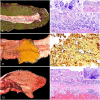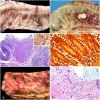Bacterial and viral enterocolitis in horses: a review
- PMID: 34763560
- PMCID: PMC9254067
- DOI: 10.1177/10406387211057469
Bacterial and viral enterocolitis in horses: a review
Abstract
Enteritis, colitis, and enterocolitis are considered some of the most common causes of disease and death in horses. Determining the etiology of these conditions is challenging, among other reasons because different causes produce similar clinical signs and lesions, and also because some agents of colitis can be present in the intestine of normal animals. We review here the main bacterial and viral causes of enterocolitis of horses, including Salmonella spp., Clostridium perfringens type A NetF-positive, C. perfringens type C, Clostridioides difficile, Clostridium piliforme, Paeniclostridium sordellii, other clostridia, Rhodococcus equi, Neorickettsia risticii, Lawsonia intracellularis, equine rotavirus, and equine coronavirus. Diarrhea and colic are the hallmark clinical signs of colitis and enterocolitis, and the majority of these conditions are characterized by necrotizing changes in the mucosa of the small intestine, colon, cecum, or in a combination of these organs. The presumptive diagnosis is based on clinical, gross, and microscopic findings, and confirmed by detection of some of the agents and/or their toxins in the intestinal content or feces.
Keywords: colitis; enteritis; enterocolitis; horses; review.
Conflict of interest statement
Figures




References
-
- Ackermann G, et al.. Isolation of Clostridium innocuum from cases of recurrent diarrhea in patients with prior Clostridium difficile associated diarrhea. Diagn Microbiol Infect Dis 2001;40:103–106. - PubMed
-
- Alberdi MP, et al.. Expression by Lawsonia intracellularis of type III secretion system components during infection. Vet Microbiol 2009;139:298–303. - PubMed
-
- Aldape MJ, et al.. Clostridium sordellii infection: epidemiology, clinical findings, and current perspectives on diagnosis and treatment. Clin Infect Dis 2006;43:1436–1446. - PubMed
-
- Arroyo LG, et al.. Experimental Clostridium difficile enterocolitis in foals. J Vet Intern Med 2004;18:734–738. - PubMed
Publication types
MeSH terms
LinkOut - more resources
Full Text Sources
Miscellaneous

